Atlantic crossing from St. Kitts to Horta
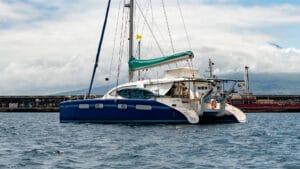
Esther and Lincoln are friends of mine from St. Lucia. They have a Leopard 4600 catamaran named Cyrilla, and I joined Lincoln on an Atlantic crossing to the Azores in May of 2025.
Cyrilla
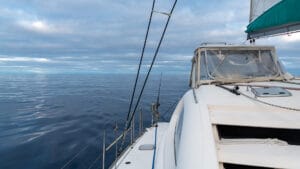
This is my first offshore experience on a catamaran. The differences between monohulls and catamarans are significant, and it takes some time to get used to them. Primarily, the catamaran has a different sea motion than a monohull. While I’m used to extreme angles of heel, lateral movement on a monohull is like a pendulum, and the body adjusts subconsciously to the regular movement. Catamarans, on the other hand, don’t heel at all. However, there is a constant lateral jerking motion that is difficult to get used to.
Preparations
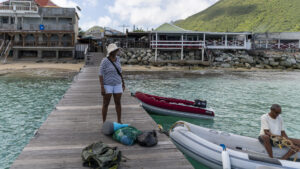
The preparations for the Atlantic crossing were a bit convoluted. I stored Zanshin in Jolly Harbour, Antigua. Lincoln sailed up from St. Lucia and picked me up, whereupon we sailed to St. Kitts and Nevis to pick up Esther. From there, we sailed to St. Martin for several days of provisioning and then sailed back to St. Kitts and Nevis to drop Esther off again.
 Atlantic crossing day 01 - May 17, Saturday
Atlantic crossing day 01 - May 17, Saturday
 Atlantic crossing day 01 - May 17, Saturday
Atlantic crossing day 01 - May 17, Saturday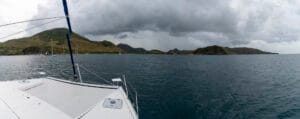
We departed White House Bay in St. Kitts at 06:30 and motored part of the way to The Narrows between St. Kitts and Nevis. Once the wind filled, we shut down the engines and began our sail to the distant Azores.
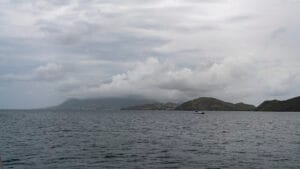
The winds were sporty, and we did over 8 knots most of the day. Towards late afternoon, the overcast skies darkened, and we approached a line of thunderstorms and squalls. We put 2 reefs in the main and the jib before the winds hit us. It turned into sustained 30+ knots, and Lincoln decided to heave to. Cyrilla hove to very nicely indeed, and we lay ahull for two hours, doing between 1 and 3 knots downwind in very stable conditions. The winds howled, gusting to over 40 knots at times, and the rain came down. The closest lightning was less than 1 second away.
When most of the storm had passed, we started the engines and tried to get going again, but all we did was spin in circles! The rudders seemed to have no effect, and we feared steering issues. It was dark, and we were both cold and tired, but we were in no immediate danger, so the choice to remain hove-to until daylight was easy. I slept first and had a late watch; it was uncomfortable and cold in the wind, but no other ships were out there, and at our drift rate, it would take over a day before we’d approach and drift by St. Barths.
 Atlantic crossing day 02 - May 18, Sunday
Atlantic crossing day 02 - May 18, Sunday
 Atlantic crossing day 02 - May 18, Sunday
Atlantic crossing day 02 - May 18, Sunday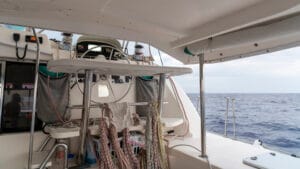
At sunrise, we got up and Lincoln dove off the back to check the rudders and props. We’d tied a safety line, and we were drifting only very slowly, so the only danger to Lincoln was the wave action off the transom. The underwater gear was still there and functioning, so we finished our tack to get out of lying a-hull and got sailing again.
After a short while, Lincoln noted that the compass was off by around 180 degrees! I said that I could only think of a large chunk of metal doing that, and looked under some sailing gloves to see if anything was there. But Lincoln picked up my torch, and the compass immediately swung back – my flashlight has a very powerful magnet at the end, and this was causing mayhem. We think that the fluxgate compass is also located behind the panel, and my flashlight was the proximate cause of our problems the night before. Visibility was 0, so we were using the instruments to guide us, and without a compass reading, we were turning in circles.
We’d lost 14 hours, and that put us behind the wind curve – we’d missed good winds and were going to have trouble catching up. The day’s sailing started with high speed and big waves, but during the day, both got lighter, and by nightfall, the winds were down to 10 knots.
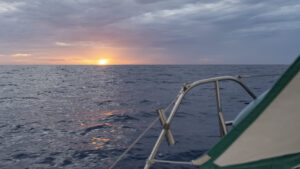
We used the Ninja Foodi to make steamed potatoes and some of our chorizo sausages for dinner.
Lincoln and I chose to use a 2-person watch schedule recommended to us by Mark, a mutual friend and experienced sailor. This rotating watch schedule is:
00:00 – 04:00
04:00 – 08:00
08:00 – 13:00
13:00 – 18:00
18:00 – 00:00
This schedule gives us a different shift each day, since there are 5 time slots. The 6-hour shift from 18:00 to midnight allows for a 6-hour sleep period.
 Atlantic crossing day 03 - May 19, Monday
Atlantic crossing day 03 - May 19, Monday
 Atlantic crossing day 03 - May 19, Monday
Atlantic crossing day 03 - May 19, Monday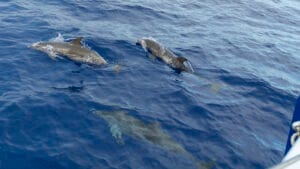
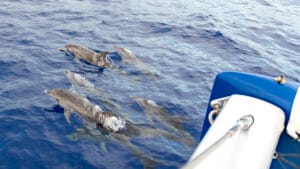
The night watch was uneventful. I had a single lightning strike upwind, and when the winds started getting stronger, I prepared to reef the jib but never had to. We had some fast sailing during the night, but then we lost most of our wind. We hadn’t had any sunshine since we departed, so our battery charge level was getting relatively low. We turned on one engine to around 1000 RPM at 04:00 to charge the batteries and provide some propulsion in the low-wind conditions. We ran that engine until 13:00, when the wind picked up again, allowing us to continue our trip without the benefit of the iron genny.
The weather routing looks a bit gloomy for a fast passage. We are chasing a wind pocket and won’t catch it. This means that we’ve got extended periods of light wind and motorsailing ahead of us. Of course, the weather models are only accurate in the very short term, so we might get lucky and still find winds in the next couple of days.
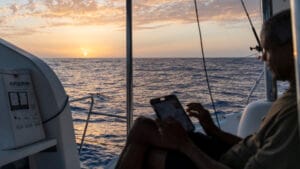
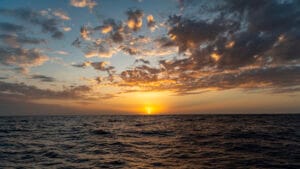
We air-fried our bacon in the Ninja and made BLT sandwiches for lunch. The bread was frozen baguettes thawed out and crisped, along with our (slowly wilting) lettuce and tomato. We’d purchased some very nice, handmade truffle-infused mustard that paired perfectly with lunch.
Dinner was made using the Ninja again – potato wedges with some burgers, and we used our last lettuce and tomato slices for that.
 Atlantic crossing day 04 - May 20, Tuesday
Atlantic crossing day 04 - May 20, Tuesday
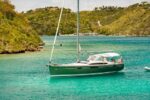 Atlantic crossing day 04 - May 20, Tuesday
Atlantic crossing day 04 - May 20, TuesdayThe winds stayed light all night but still allowed us to travel at 3 knots for much of the dark hours. We can’t hold the recommended heading and are going more north than east. But with the light winds forecast for later in the day and for the following days, this shouldn’t be a huge problem, as we’ll be able to make up the angle under engine power.
Breakfast was a nice, fluffy omelette, and Lincoln said that was the first time the stovetop had been used in months, since the Ninja can do almost everything. But the cooking pot is too deep for a good omelette, so the Ninja got a rest.
Another reason was that the batteries were relatively low in the morning, so we didn’t want to use too much electricity before the solar panels could recharge. By late afternoon, the batteries were back to 100%, and the panels were putting out over 1 kW of power most of the day. We are going to have to be a bit careful with our overnight power consumption going forward.
I spent my day working on the computer, while Lincoln busied himself with boatwork and enjoyed the ocean view. For dinner, we polished off some potatoes that were on the verge of going bad. I had mixed vegetables, and Lincoln cooked up a fish he’d caught last week.
The winds failed us around 17:00, and we had to furl the sails. We are now running with just one engine at just over 1000RPM, using exactly 1L/hour. While this is very efficient and low-consumption, we are only moving through the water at a maximum speed of 3 knots.
I’ve got the 18:00 to midnight watch and am typing this text. There are no ships in sight, and the AIS and radar remain silent as well.
 Atlantic crossing day 05 - May 21, Wednesday
Atlantic crossing day 05 - May 21, Wednesday
 Atlantic crossing day 05 - May 21, Wednesday
Atlantic crossing day 05 - May 21, Wednesday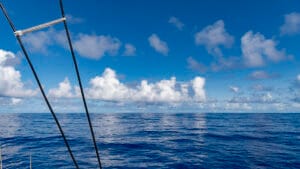
The winds haven’t filled in yet, so much of the day was spent motorsailing with one engine or the other running at just over 1000 RPM and burning around 1 L/hour of fuel. While the consumption remains low, so does our progress on this Atlantic crossing toward the Azores.
I spent the morning hours working on the computer. We’d rigged two towels on the outside of the window next to the navigation station as an impromptu shade, which both cooled it and improved visibility to my monitor.
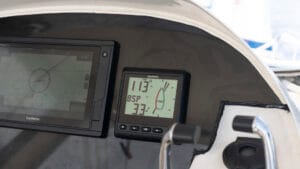
We made a late breakfast (or an early lunch) of omelettes today, frying up the leftover potatoes and toasting some of our remaining bread. Some of the rolls in the fridge needed to be tossed, as they were sprouting growths that weren’t very appetising.
Our friends on LUWINA, Luise and Uwe, are also crossing the Atlantic and heading towards the Azores. They are having the other extreme of weather with 20+ knots of wind and larger waves from astern. Hopefully, they’ll get respite from the inclement weather soon and enjoy the crossing. They are located to the north and east of Bermuda and should arrive several days before we get there.
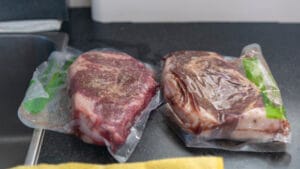
We finally made our first steaks on the BBQ today. Two of our vacuum-sealed steaks went into the Ninja in sous vide mode for 2 hours. We prepared a sauce from a beef stock cube, onions and garlic sweated in the pan, and some water to let it reduce, then added milk (in place of cream) and a flour thickener.
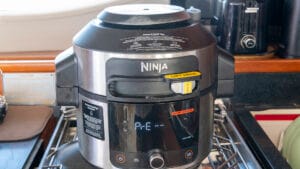
The Ninja did double duty as a steamer for the potatoes. We fired up the Force 10 BBQ, got it very hot to sear our steaks, and soon had a complete meal ready in the cockpit, just as the sun set on the horizon. The steaks were perfect, a successful first sous vide experiment for Lincoln.
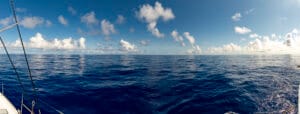
 Atlantic crossing day 06 - May 22, Thursday
Atlantic crossing day 06 - May 22, Thursday
 Atlantic crossing day 06 - May 22, Thursday
Atlantic crossing day 06 - May 22, Thursday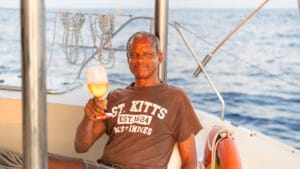
I had the 00:00 to 04:00 watch, and we still had to run an engine to keep up the modest speed of 3-4 knots. It is still a very long way to the Azores, and unfortunately, not a very long way back to our starting point. But sometime today or tomorrow, we’ll pick up some wind and be able to continue without the constant background sound of an engine running.
I didn’t get much sleep after my watch, as I had my first of several conference calls at 07:00. The calls seemed interminable. Still, by midafternoon, I was finished with my virtual office and could enjoy the excellent sailing conditions outside. We didn’t have much wind, never exceeding 8 knots, but made 4-5 knots through the water steadily in the correct direction, and little ocean swell while enjoying warm sunny weather. Apart from the slow progress, it was champagne sailing aboard Cyrilla today.
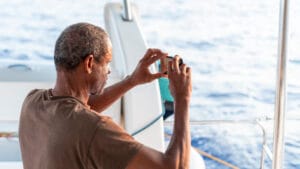
The breakfast pancakes were a disappointment, but our simple dinner of steamed and then fried potatoes with BBQ chorizo hit the spot, and the meal culminated in a glorious offshore sunset.
My watch lasted until midnight, when Lincoln relieved me, and I didn’t have to return until 04:00 the following day.
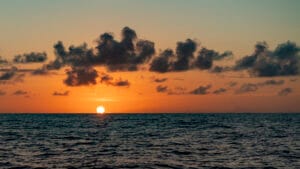
 Atlantic crossing day 07 - May 23, Friday
Atlantic crossing day 07 - May 23, Friday
 Atlantic crossing day 07 - May 23, Friday
Atlantic crossing day 07 - May 23, Friday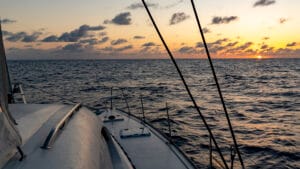
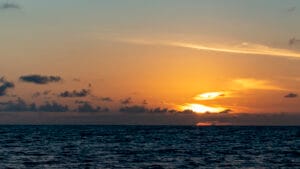
Our wind has come back, at least partially. We had a good 10 knots of breeze for most of the day and were able to sail at 6 knots or more for much of the time. With speeds like this, our Atlantic crossing will go fast. The waves are still acceptably small and well separated. We are also seeing a lot less sargassum, and hopefully, we will see the last of that nasty stuff soon.
There’s been a surprising amount of traffic around us, although only two cargo vessels came close enough to be seen with the naked eye. There’s another sailboat 9 miles off our port side that is on almost the same course, and our speeds are close enough so that we’ll be in AIS range for a long time.
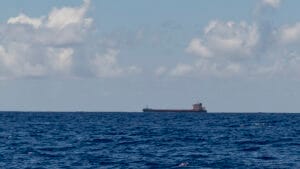
Dinner turned out to be a hit. I made meatballs (with a binder of milk, egg, and crumbled saltines), and the Ninja Foodi did the real work in pressure-cooker mode. The combination of spices, angel hair pasta, and the meatballs in tomato sauce turned out tasty and went well with a bottle of wine.
 Atlantic crossing day 08 - May 24, Saturday
Atlantic crossing day 08 - May 24, Saturday
 Atlantic crossing day 08 - May 24, Saturday
Atlantic crossing day 08 - May 24, SaturdayWe had light winds again all day, but Cyrilla is very fast in light winds, often doing 5-6 knots in less than 10 knots of wind. We use weather routing from PredictWind, which incorporates the four most popular weather models (ECWMF, GFS, SPIRE, and UKMO) and two of their hybrid models for routing planning. We download the latest weather GRIBs several times daily and have the system run for each weather route. We’ve entered Cyrilla’s polars and adjusted our preferences, for example, that we prefer comfort over speed and will motor at 3 knots if the boat speed goes below 3. We also placed limits on high-wind and high-wave conditions that we aren’t willing to sail into.
Routing
Each routing run that we do utilizes our current position, and it amazes us how different the results are between runs. The most recent one has some going far north and some far south to get optimal results; the distance between them is 700NM!
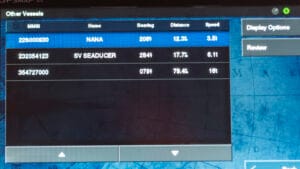
The day went by quickly, and there was a surprising amount of traffic. I’ve never seen so many AIS targets at sea before. Not only did we have hits at 90NM, but we also had some sailboats, one is Nana and the other is SV Seaducer. Both are on parallel courses, and Nana is ahead of us, but slower, while SV Seaducer is faster than we are and will pull away from us sometime during the night.
Longlines
We encountered 3 Chinese longline ships spaced 6 NM apart, moving at 0.3 knots; they probably have their lines out and are waiting for the tuna to bite before hauling them in. I read up on longline fishing and was surprised to learn that tuna live at depths of 100-300m, and that the longlines trailing behind the fishing boats can be over 50 miles long!
We’d bought some gourmet Appenzeller and ate it with crackers for an afternoon snack, then reheated the spaghetti meatballs from the day before in the Ninja. They tasted better after a day of resting and maturing in the fridge.
I had watch until midnight and used the freshly downloaded SkyMap app to sit forward and identify stars and constellations. The night sky at sea is impressive, as there is no light noise pollution to dim the view.
The VHF went off with a boat hailing us; it was Nana. After exchanging pleasantries (they were two on board plus a dog) and confirming we were both heading to the Azores, they came to the heart of the matter: we were asked whether we were motoring (we were doing about 6 knots in 9 knots of wind), and they had trouble believing us. I confirmed that I was a monohull sailor and would have also disbelieved the high speed. We agreed to have some drinks together in Horta, and we pulled ahead of them at about 2-3 knots.
 Atlantic crossing day 09 - May 25, Sunday
Atlantic crossing day 09 - May 25, Sunday
 Atlantic crossing day 09 - May 25, Sunday
Atlantic crossing day 09 - May 25, Sunday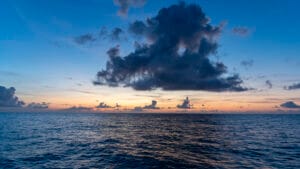
The winds remained low all night, and the waves all but disappeared. When I went on watch at 04:00, the sky was already beginning to lighten, and the stars were no longer visible. Only Venus remained visible. The sunrise was glorious, and it is always thrilling to catch the first ray of sunlight on the horizon. From that first moment to full sunrise, it lasts only a short while; the sun seems to pop up in a hurry.
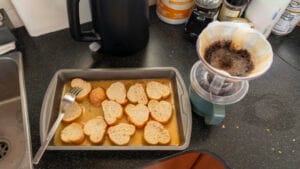
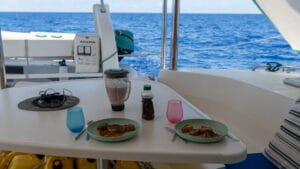
We had half a baguette left in the freezer and made French toast for breakfast, accompanied by a smoothie made with most of our fresh fruit, which was in danger of overripening.
We had another good day of sailing and have covered just under 1000 miles so far, and we’ve got 1300 miles ahead of us. We hope we’ll be able to keep this pace; if we do, we’ll be at or past our halfway point in terms of time, and tomorrow we’ll hopefully have covered half the distance as well.
Motoring
A couple of hours of motoring with one engine spoiled our progress record, but kept us moving in light winds. We seem to have crossed a shipping channel during the day, with several cargo vessels visible on AIS, which were on opposite courses. We crossed that virtual path with nothing getting within 20 NM of us.
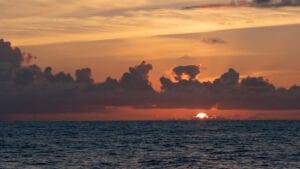
Dinner was a collaborative effort. We made a potato gratin in the Ninja with a tasty bechamel sauce and added some Merguez sausage grilled on the BBQ. The meal was accompanied by an Argentine red wine we’d purchased at Bacchus.

 Atlantic crossing day 10 - May 26, Monday
Atlantic crossing day 10 - May 26, Monday
 Atlantic crossing day 10 - May 26, Monday
Atlantic crossing day 10 - May 26, Monday
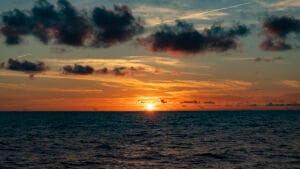
The winds stayed light and shifty. My watch from midnight to 04:00 began with turning on one engine to keep the poor autopilot from working too hard in the waves. The night sky is impressive, with a plethora of stars shining and the Milky Way glowing. I’m writing this entry and sending some emails with the cockpit light turned on, but once I’m finished, I’ll extinguish all the lights and go back to stargazing.
The day was uneventful; we had several AIS hits on tankers and freighters, but only one was close enough to make out visually. Then the winds remained light, and we had to use the engine all day.
Lincoln has been fishing without success, apart from catching the occasional clump of sargassum. I went forward to the bow during the day to gaze at the water and sky, and noted that biggish fish were swimming just ahead and to the side of the boat. I grabbed the fishing rod and tried unsuccessfully to lure them from the bow rather than the stern.
Lincoln then noted that the fish were small tuna and went to work with a second rod, switching the lures. The fish just sniffed around the bait once and went back, teasing poor Lincoln. I was reminded of a bumper sticker from the USA: ‘Vegetarian – Indian word for “bad hunter”’
We had two packets of vacuum-sealed “Stew Beef” in the freezer, and I chose to make a boat version of Hungarian Goulash. We thawed the beef in the Ninja in sous-vide mode, then I cut it into smaller pieces and seared them. Next, I added onions, garlic, and carrots. After sautéing those, some tomato paste and paprika seasoning went into the mix, then some flour as a binder/thickener, and a Liter of beef broth made from cubes.
Then the Ninja did its magic with the pressure cooker for 40 minutes while we boiled the rest of our potatoes for the side. The meal was a success, and I think the leftovers will be even better when we eat them tomorrow.
 Atlantic crossing day 11 - May 27, Tuesday
Atlantic crossing day 11 - May 27, Tuesday
 Atlantic crossing day 11 - May 27, Tuesday
Atlantic crossing day 11 - May 27, TuesdayThe winds are still light, and we have the engine running at 1000 RPM to keep us moving at a pace that prevents our jib from flapping. The sea state is getting higher, so we are optimistic that we’ll get sufficient wind later in the day.
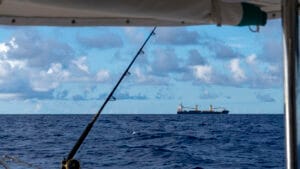
My office work began with my watch starting at 04:00, and I attended videoconferences that I usually am still asleep for. There’s only one ship on the AIS, and it shows it will be only 1 NM away at CPA (closest point of approach).
The winds started filling in, preceded by a marked increase in wave height. The seas are now quite choppy with 15-18 knots of breeze behind us, and we’ve changed course to go almost due east. According to the most recent weather models, this will let us go south of a system moving through during the night, which would bring adverse winds and slow our progress towards Horta.
We’ve now passed the halfway mark and made 108 NM yesterday, which was more than I’d expected considering the amount of time we spent motoring at 3 knots. The weather models generally agree that we’ll reach the Azores on June 6th, yet I’ll wager it is more likely we get there on the 7th.
Lincoln and I still see the school of tuna off to the side of the boat, but they remain steadfastly resistant to his lures. They seem to be using Cyrilla as a FAD (fish attraction device), which makes the flying fish shoot off to the side and provides a steady diet for the tuna.
 Atlantic crossing day 12 - May 28, Wednesday
Atlantic crossing day 12 - May 28, Wednesday
 Atlantic crossing day 12 - May 28, Wednesday
Atlantic crossing day 12 - May 28, WednesdayThe prediction and weather-routing software uses six weather models. Each of these requires supercomputers’ computing time. Despite this huge computing capacity, all the models showed us to expect following winds with about 10 knots. We had wind on the nose at 20+ for much of the night and morning, 180 degrees away from the models. One needs to realize that these predictive models make no pretensions to accuracy, and at a micro scale, they will often be wrong, given that the data points are 50 km apart. At a macro scale, they remain quite accurate.
Lincoln and I looked at the polars and decided that the warm convection pattern was about 20 miles further north in the model than in real life, and we headed south to avoid the strong headwinds. Several hours later, we were rewarded with a zone that had light tailwinds, and we turned east again. This has been ongoing since approximately 14:30 and will continue until midnight. We then expect strong 20+ knots from abeam to propel us to the ENE and closer to the Azores.
I spent 8 hours on the computer in the virtual office today. It wasn’t easy. The constant movement of Cyrilla in the seas made using my mouse impossible due to the jerky nature of the boat’s motion through the water. I was a bit queasy for a while, but never had to escape my conferences or computer work to get some fresh air and shake off any oncoming nausea.
The winds passed during the day, and the seas became calm again, and we had to turn on an engine to make some headway, however slowly.
We made lasagna for dinner and sipped some excellent 21-year-old El Dorado rum from Guyana. Lincoln went off to sleep, and I had the watch until midnight. The winds remained light, and the expected 20 knots from aft didn’t materialize.
 Atlantic crossing day 13 - May 29, Thursday
Atlantic crossing day 13 - May 29, Thursday
 Atlantic crossing day 13 - May 29, Thursday
Atlantic crossing day 13 - May 29, ThursdayWhen I came on watch at 04:00, the winds had picked up. Lincoln had taken down the main, and we are doing 7 knots with just the jib. The seas have grown and are quite lumpy, and this weather is expected to remain for the next 2-3 days as the low-pressure system passes. The disorganization in the wave trains settled into a more regular pattern as the day progressed, and the wind remained around 20-22 knots for most of the day. We put a single reef in the jib and sailed at around 7 knots, and by midafternoon, we could walk about the boat more comfortably.
I worked at the computer, and it was a bit difficult, particularly since the mouse kept wandering across the navigation station’s writing surface and was basically unusable. However, the touchpad on my old notebook still functioned, allowing me to move the cursor around the screen with some semblance of accuracy.
We chose to make a simple dinner in the Ninja: rice and some spicy chicken. I went to sleep shortly after dinner, as my next shift starts at midnight.
 Atlantic crossing day 14 - May 30, Friday
Atlantic crossing day 14 - May 30, Friday
 Atlantic crossing day 14 - May 30, Friday
Atlantic crossing day 14 - May 30, Friday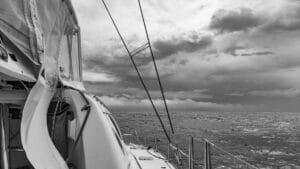
When I came on watch at 04:00, the winds had picked up. Lincoln had taken down the main, and we are doing 7 knots with just the jib. The seas have grown and are quite lumpy, and this weather is expected to remain for the next 2-3 days as the low-pressure system passes. The disorganization in the wave trains settled into a more regular pattern as the day progressed, and the wind remained around 20-22 knots for most of the day. We put a single reef in the jib and sailed at around 7 knots, and by midafternoon, we could walk about the boat more comfortably.
I worked at the computer, and it was a bit difficult, particularly since the mouse kept wandering across the navigation station’s writing surface and was basically unusable. However, the touchpad on my old notebook still functioned, allowing me to move the cursor around the screen with some semblance of accuracy. The Atlantic crossing miles ahead of us looked interminable.
We chose to make a simple dinner in the Ninja: rice and some spicy chicken. I went to sleep shortly after dinner, as my next shift starts at midnight.
The winds had died down shortly before I went on shift, and we decided to run an engine at 1000RPM again to get our speed over 3 knots. I shut the engine down a half-hour later as the winds picked up a bit again, and Cyrilla bounced through the waves at 4-5 knots again.
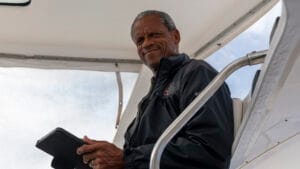
There are 3 sailboats in AIS range in the wee hours of the morning, and they are all heading in roughly the same direction at different speeds, so our navigation can’t be far off. There’s a large 75-foot Oyster called “S/Y Clarelsa” that is speeding along past us, and a 30ish monohull called “Camogli” is pacing us as well. The third AIS hit is intermittent.
It was too rough for breakfast, even though I did risk life and limb to make a coffee. Work on the computer was difficult again in these heavy seas. My mouse was useless, and the notebook’s integrated mousepad had to suffice. However, at least I had some success at work, locating and fixing a difficult-to-isolate bug in the software we use to load the data warehouses.
I took a 2-hour nap in the afternoon, which revived me, though staying alert from 18:00 to midnight is still going to be challenging. Dinner consisted of oven-heated lasagna. The seas were too rough to imagine making a meal in the galley. It is impossible to walk aboard Cyrilla without holding on to something, and sometimes even that is barely enough to keep from falling over onto something.
The port engine bilge alarm has been sounding intermittently throughout the day. There’s a small amount of water in the sump that the pump can’t drain. In heavy seas, the water sometimes sloshes over the sensor, and the pump initiates. The beeping is loud in my cabin, so I can only sleep with earplugs. They work very well – too well, as the alarm on my smartphone isn’t loud enough to overcome their sound insulation.
It is a quarter to 9 PM right now, and I’ve relocated to the internal navigation station. I’d been sitting out at the helm for the past 2 hours and allowing myself to chill to the bone. With heavy cloud cover and a new waxing moon, visibility up top is zero, so sitting in the wind, rain, and cold is a waste of time. It is warmer in here, but the boat movement is still quite jerky, and writing this text isn’t any fun. We have another 24 hours of heavy weather ahead of us, then the rest of the trip should be in much lighter winds and calmer seas.
 Atlantic crossing day 15 - May 31, Saturday
Atlantic crossing day 15 - May 31, Saturday
 Atlantic crossing day 15 - May 31, Saturday
Atlantic crossing day 15 - May 31, SaturdayWind and waves as far as the eye can see. Which wasn’t very far considering the rain coming down. The conditions were difficult for most of the day. Big seas all around, with some 10+ foot waves, made life aboard uncomfortable. The banging and slamming on the hull made sleep below well-nigh impossible, and even in the salon area, it wasn’t much better.
On the upside, we did pretty well and made our best day of 172NM, but that came at a price, and both of us were tired.
Respite began at 16:00 when we broke through into the high-pressure area, and the wind dropped to 20-25 knots, with the commensurate waves subsiding as well. Seas remained lumpy, and our dinner of fried rice with some fried sausages and greens was a simple affair.
The highlight of the day was watching some dolphins frolic at the bow of Cyrilla
 Atlantic crossing day 16 - June 1, Sunday
Atlantic crossing day 16 - June 1, Sunday
 Atlantic crossing day 16 - June 1, Sunday
Atlantic crossing day 16 - June 1, SundayMy shift started at midnight, and conditions out here are much better. The wind is around 10 knots, and despite the still churned-up seas, we are doing 4-5 knots. Things will look better at sunrise, and we’ll set the main and let the reef out of the jib to make some more headway.
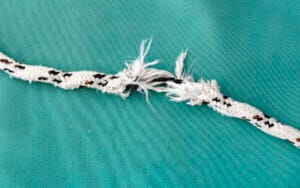
We raised the mainsail in the morning, and our speed jumped up; the sum of both sails working together exceeds that of each sail on its own. We’d been using a barber hauler to pull out the jib and decided it was time to remove it. This was expedient, as the jib sheet had almost chafed completely away on a stainless-steel handrail during the heavy weather sailing of the past two days. We tacked to relieve pressure on the line, then untied it and end-to-end it. Luckily, the line was more than long enough for us to cut away the chafed portion and whip it. Once the line was fixed, we tacked back on course and sailed in light winds all day. Despite this, we made good progress.
After a visit from a large pod of dolphins, we began preparing dinner. This was to be a sous vide chicken breast with vegetable rice. After the sous vide time was complete, we put a rub on the chicken and wanted to grill it on the BBQ, but the rotary control didn’t want to play along, and I suspect we’ll have to use some WD-40 to get it moving again. In the interim, we sautéed the chicken and had a satisfying dinner.
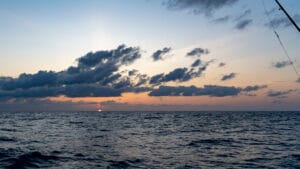
Lincoln went to sleep, getting some shuteye before going on watch at midnight. I’ve got to try to remain awake and alert until then. I get to sleep during his 4-hour watch, only to return to duty at 04:00.
 Atlantic crossing day 17 - June 2, Monday
Atlantic crossing day 17 - June 2, Monday
 Atlantic crossing day 17 - June 2, Monday
Atlantic crossing day 17 - June 2, MondayWith seas like glass, the morning was calm. This meant that we needed to turn on an engine to make any progress. During the day, the winds got a bit better, and at 16:00, we could finally return to being a pure sailboat. I spent much of the day working on the computer. The temperatures are distinctly cooler now, although I did try wearing shorts for a while before reverting to long sweats.
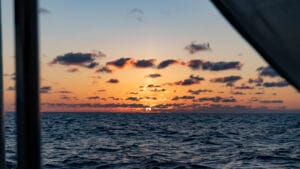
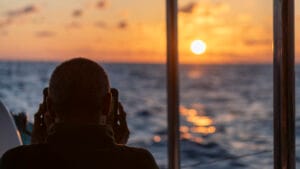
As the spaghetti meatballs had been a success several nights ago, I chose to make them again. They turned out tasty again, but I’d had to throw out one container of mince because it had started to turn after I’d measured out the ingredients, so the resulting meatballs were very soggy and wouldn’t hold shape until I’d given them a good fry.
 Atlantic crossing day 18 - June 3, Tuesday
Atlantic crossing day 18 - June 3, Tuesday
 Atlantic crossing day 18 - June 3, Tuesday
Atlantic crossing day 18 - June 3, TuesdayI have the midnight to 4 AM watch again. The winds are now around 15 knots, and we are making way at 7 knots, but poor Cyrilla (and contents) are being shaken up and slamming into the short, steep swell. Regardless, it beats motoring at 3 knots!
Most of the day was somewhat uncomfortable aboard. Once the sun set, the winds and waves slowly began to settle. The slamming and splashing stopped, and by 22:00, the seas were once again flat. That allowed us to make 5 knots of speed in 9 knots of wind.
 Atlantic crossing day 19 - June 4, Wednesday
Atlantic crossing day 19 - June 4, Wednesday
 Atlantic crossing day 19 - June 4, Wednesday
Atlantic crossing day 19 - June 4, Wednesday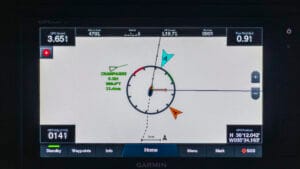
My night watch went quickly today, as I was on conference calls at work all the time. The conditions remain calm, and we’ve had to motor to get closer to the Azores. We now have less than 500 nautical miles left on our journey, and the weather forecasts all indicate mild winds and waves. We are looking for an area where the wind is in our favour, or at least not directly against us.
Part of the afternoon gave us winds, but we had to take some very long tacks north to keep the sails filled. We’ve now travelled as far north as we need, and the challenge is to make as much easting as possible with minimum engine and maximum sailing.
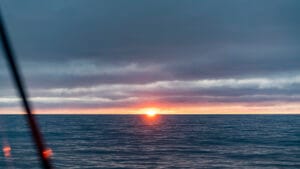
The sunset was gorgeous, and for dinner we thawed our remaining 2 gourmet burgers from Carrefour. I baked a loaf of bread to accompany the meat, and Lincoln used the Ninja to air-fry some frozen French fries. Lincoln had also gotten the BBQ going again. The heavy seas had splashed onto the BBQ control dial, and it had frozen solid, turning it was only possible with pliers and the judicious use of force.
 Atlantic crossing day 20 - June 5, Thursday
Atlantic crossing day 20 - June 5, Thursday
 Atlantic crossing day 20 - June 5, Thursday
Atlantic crossing day 20 - June 5, Thursday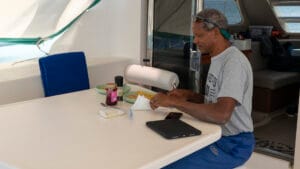
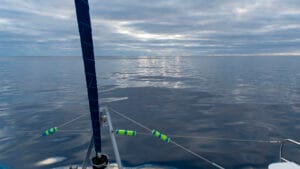
The winds remained fickle in the morning. It wasn’t until the early afternoon that they finally strengthened and came from the north and west so that we could turn off the engine and sail at speed towards the Azores. We then made 5-7 knots on a heading of 75 degrees in Cyrilla’s Goldilocks setting of 60 degrees to the wind.
Our friends on Luwina arrived in Ponta Delgada after their long trip from the Bahamas. They reported that the marina was booked out solid from the 8th through the 14th of June, as the ARC Europe boats were staging there before departing on the last leg of their regatta.
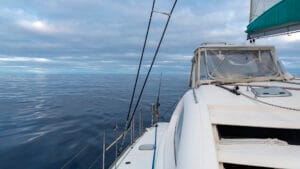
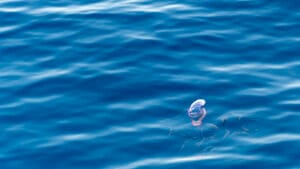
This information forced us to rethink our passage plan and change our landfall back to Horta. In one fell swoop, we shortened our travel time by over 24 hours. This means that the beer supplies will last until arrival, even though my coffee has run out.
For dinner, we reheated the leftover rice from two nights ago and grilled some sausages on the BBQ, which Lincoln has named “Erica”. At the same time, the autopilot has been christened “The Dude” for his unwavering duty of steering Cyrilla with nary a complaint or hiccup. So goes our Atlantic crossing.
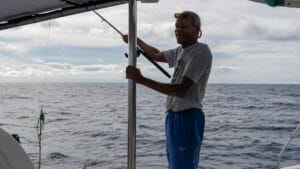
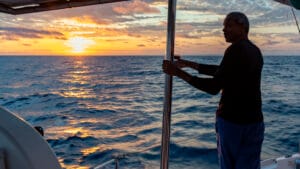
Lincoln managed to catch some fishing line today. It gave up the fight quite quickly and let itself get reeled in. That prompted him to stop fishing for the day. Soon thereafter, we saw a huge pod of big dolphins pass aft of the boat. They weren’t interested in us, but seemed to be hunting or feeding. They were accompanied by a flock of sea birds that evidently wanted to participate in dinner as well.
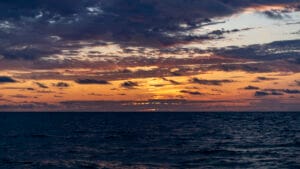
 Atlantic crossing day 21 - June 6, Friday
Atlantic crossing day 21 - June 6, Friday
 Atlantic crossing day 21 - June 6, Friday
Atlantic crossing day 21 - June 6, Friday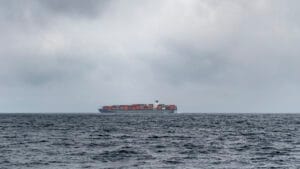
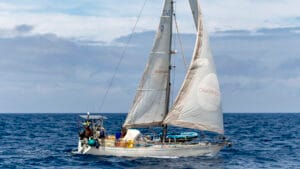
We only needed to turn on the engine for one hour in the middle of the night, when the winds became very light and shifty, and the sails were flapping about. Apart from that short period, we were able to sail all day, and in the afternoon, the winds had gone up to 10 knots and came from a direction that let Cyrilla sail in her “sweet spot” and make way on our Atlantic crossing.
We passed a Swedish boat named Champagne and came within a couple of boat lengths of it. Both of us were using our autopilots, so that would have been a close encounter had we not had AIS warn us of it hours beforehand.
We hailed each other on the VHF and chatted for a bit. They are two aboard, have just completed a circumnavigation, and are on their way back to Sweden. Hopefully, we can meet up in Horta and hear some stories.
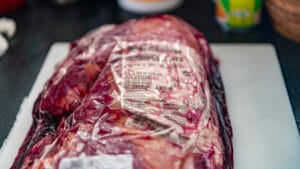
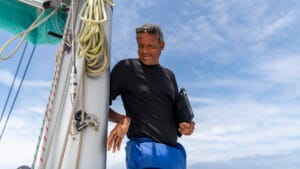
Despite the somewhat choppy seas, I managed to get the PSMO side of tenderloin out of the fridge and butcher it into several juicy steaks and some stew beef. The steaks were vacuum-sealed and frozen, except for the two largest, which we put into the sous vide cooker in preparation for a steak BBQ dinner. We still had a bag of French fries that went into the air fryer. I made a simple mushroom sauce with canned mushrooms and caramelized onions. Lincoln brought out a secret stash bottle of St. Emilion Bordeaux, and the meal was a hit – not a morsel of food was left on any of the plates once we’d finished eating.

 Day 22 - June 7, Saturday Arrival
Day 22 - June 7, Saturday Arrival
 Day 22 - June 7, Saturday Arrival
Day 22 - June 7, Saturday ArrivalI’m on watch from 00:00 to 04:00 again. At 00:45, we were only 33.3 nautical miles from Horta. It is still dark outside, and no lights are visible, although the AIS shows several sailboats heading towards that anchorage. Two of them are ahead of us, but the rest are behind. The marina is crowded, and we don’t know if there will be room at any of the docks for us. But the alternative of anchoring out is also acceptable for us. And that would mean that we wouldn’t need to worry about rafting – something neither of us has done nor wishes to do.
Time Zones
Our clocks are all still set to Caribbean time. As we’ve sailed both east and north on the Atlantic crossing, we’ve been in 3 time zones, and the sun rises at about 2:30 AM and sets around 6 PM. We’ve just come within cell phone range of Faial, and my phone jumped ahead 4 hours; I’ve changed my PC to reflect that as well. Once Lincoln is up, we’ll switch the rest of the devices aboard so that they reflect the Azores time, which is UTC -1 hour. Since the Azores are on summer time, this equates to exactly UTC.
The sun is about to rise as I write this. I can see the seas around me in the morning gloaming. But there’s still no land in sight ahead, Faial is still over 20 miles distant, and visibility isn’t perfect.
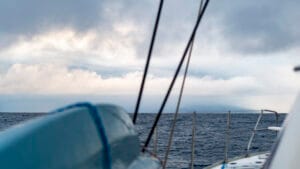
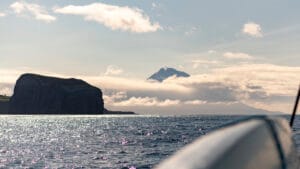
Land in sight! I had to go forward just now to remove the two towels that I’ve been using as sunblock from the forward window. While doing so, I had an unobstructed view forward and could just make out the island of Faial ahead. There is a low stratus overcast this morning, and most of the island isn’t visible. Perhaps the clouds will burn off as the sun rises, giving us a view of the land ahead.
We made it into the anchorage at noon, and it was quite crowded. As we motored slowly around, looking for a suitable spot, a boat in a prime location weighed anchor, and we were there as soon as they’d vacated their spot and dropped the hook. This was fortuitous, as the anchorage is full due to the ARC boats, and there’s little room left available. We’d been informed on the VHF to use only the southern portion of the anchorage, which rules out most of the available acreage.
Ashore
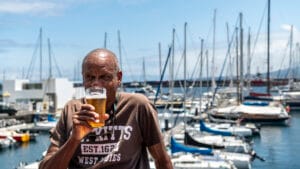
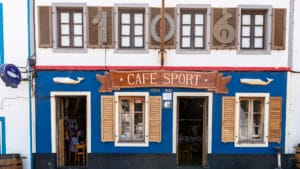
Lincoln had already gotten all the paperwork put together, and we soon had our shore clothes on and boarded the dinghy, which fired up on the first press of the starter button. Since the office was closed for lunch, we walked around and had a celebratory cold beer ashore before Lincoln got in line at the marina office, and I walked around the entrance. Clearing in took quite a while, but mainly because the official had to manually type in all the details. By the time Lincoln came out with the signed paperwork, I’d located Peter Café Sport, and we walked over. He’s got a good business going – 2 bars/restaurants, another store, and a clothing emporium. I bought a long-sleeved shirt with a collar, and Lincoln purchased some presents before we went into Peter Café Sport for a bit of food and drink.
We were both a bit tired and returned to Cyrilla to share a bottle of fine Champagne to celebrate our successful Atlantic crossing. My eyes started to shut on their own, but Lincoln heard some live music ashore playing the blues, and he convinced me to join him. The music had just been the sound-check, and we needed to wait for a while before their first set began.
The wait was worth it – while the trio wasn’t superb, they did great renditions of many classic blues and old rock & roll songs. They played 2 sets, and as the second set started winding down, the bar had an influx of young kids as there was a DJ and dance music on the agenda after the old farts like us went to bed. It seems that eyeshadow & cheek glitter is an “in” thing again for the girls… We made it back aboard sometime after 23:00 and soon fell asleep.
